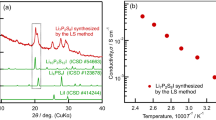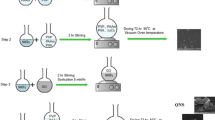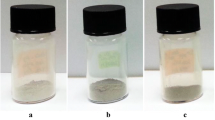Abstract
The long-time stability of the enhanced porous silicon (PS) optoelectronic properties using samarium (Sm) pore-filling were investigated based on experimental results. Non treated natural and thermally oxidized PS samples were taken as reference. The morphology evolution of the samples was observed by using a scanning electron microscope (SEM). Fourier-Transform Infrared spectra (FTIR) of Sm treated PS (Sm-PS) show the appearance of new band localized at 470 cm−1 and attributed to Sm–O-Si which is persistent after 7 months of air exposure. Photoluminescence (PL) characterization demonstrated a stable threefold increase in the PL intensity of the Sm-PS. However, a blue shift from 1.829 eV to 1.835 eV and 1.890 eV for both natural aged and the thermal annealed PS samples accompanied with a dwindling in the intensity are observed and attributed to the decrease in the silicon crystallite size. The deconvolution of Raman spectrum of Sm-PS sample shows the existence of three bonds localized at 520, 518 and 506 cm−1 and attributed to the crystalline Si substrate, the formation of silicon nanocrystallites (SiNCs) and the compressive strained PS layer after the deposition of Sm layer, respectively. The electrical properties were analyzed based on the effective minority carrier lifetime (τeff) and surface recombination velocity (Seff). The Sm treated samples show the highest τeff about 52 µs and as a result the lowest Seff comparing to the freshly prepared PS which exhibits a τeff of about 13.2 µs due to the passivating capability of Sm layer. These results highlight the effectiveness of coating PS with Sm layer suitable for light emission and photovoltaic applications.
Similar content being viewed by others
Data Availability
The datasets generated and analyses during the current study are available from the corresponding author on reasonable request.
References
Ibraheem S, Yasin G, Iqbal R, Saleem A, Nguyen TA, Ibrahim S (2022) Silicon-based nanomaterials for energy storage. In: Silicon-Based Hybrid Nanoparticles, Elsevier pp 103–124
Marchant C, Williams RM (2023) Perovskite/silicon tandem solar cells–compositions for improved stability and power conversion efficiency. Photochem Photobiol Sci 23(1):1–22
Cassio F, Poffo L, Lorrain N, Pirasteh P, Lemaitre J, Guendouz M (2022) Polarization-dependent losses in porous silicon ridge waveguides. Results Opt 9:100269
Zhang Y, He Y, Wang H, Sun L, Su Y (2021) Ultra-broadband mode size converter using on-chip metamaterial-based Luneburg lens. ACS Photonics 8:202–208
Kareem MH, Hussein HT, Abdul Hussein AM (2022) Study of the effect of CNTs, and (CNTs-ZnO) on the porous silicon as sensor for acetone gas detection. Optik (Stuttg) 259:168825
Chin GP, Guo K, Vasani R, Voelcker NH, Prieto-Simón B (2024) Carbon-stabilized porous silicon biosensor for the ultrasensitive label-free electrochemical detection of bacterial RNA gene fragments. Biosens Bioelectron X 16:100438
Bakshi S, Pandey P, Mohammed Y, Wang J, Sailor MJ, Popat A, Parekh HS, Kumeria T (2023) Porous silicon embedded in a thermoresponsive hydrogel for intranasal delivery of lipophilic drugs to treat rhinosinusitis. J Control Release 363:452–463
Amri C, Ezzaouia H, Ouertani R (2020) Photoluminescence origin of lightly doped silicon nanowires treated with acid vapor etching. Chin J Phys 63:325–336
Lee S, Kang J, Kim D (2018) A mini review: recent advances in surface modification of porous silicon. Materials 11:2557
Wolkin MV, Jorne J, Fauchet PM, Allan G, Delerue C (1999) Electronic states and luminescence in porous silicon quantum dots: the role of oxygen. Phys Rev Lett 82:197–200
Murphy JD, McGuire RE, Bothe K, Voronkov VV, Falster RJ (2014) Minority carrier lifetime in silicon photovoltaics: the effect of oxygen precipitation. Sol Energy Mater Sol Cells 120:402–411
Naderi N, Rasi S, Moradi M (2018) Reduced graphene oxide as a stabilizing layer for optical properties of porous silicon. Optik (Stuttg) 172:57–62
El-Damhogi DG, El-Shabaan MM, Abul-Nasr KT, Mohamed Z, Elesh E (2023) Optoelectronic and photo response performance of n-tris phenylpyridinato iridium/p-Si heterojunction device for photovoltaic applications. Chin J Phys 85:660–673
Lenshin AS, Seredin PV, Kashkarov VM, Minakov DA (2017) Origins of photoluminescence degradation in porous silicon under irradiation and the way of its elimination. Mater Sci Semicond Process 64:71–76
Zhou J, Su X, Huang Q, Zeng Y, Ma D, Liu W, Yan B, Ye J, Yang J, Zhang X, Jin H, Zhao Y, Hou G (2022) Approaching 23% efficient n-type crystalline silicon solar cells with a silicon oxide-based highly transparent passivating contact. Nano Energy 98:107319
Zarroug A, Haddadi I, Derbali L, Ezzaouia H (2015) LiBr treated porous silicon used for efficient surface passivation of crystalline silicon solar cells. Superlattices Microstruct 80:181–187
Amri C, Ouertani R, Hamdi A, Ezzaouia H (2017) Enhancement of silicon nanowire opto-electric properties by combining acid vapor etching and lithium pore-filling. J Mater Sci: Mater Electron 28:13426–13435
Rahmani M, Moadhen A, Zaïbi M-A, Elhouichet H, Oueslati M (2008) Photoluminescence enhancement and stabilisation of porous silicon passivated by iron. J Lumin 128:1763–1766
Derbali L, Ezzaouia H (2013) Electrical properties improvement of multicrystalline silicon solar cells using a combination of porous silicon and vanadium oxide treatment. Appl Surf Sci 271:234–239
Ben Khalifa Sana, Gassoumi M, Ben Dhahbi A, Alresheedi F, elAbdeen Mahmoud AZ, Beji L (2020) The effect of the cobalt ferrites nanoparticles (CoFe2O4) on the porous silicon deposited by spin coating. Alex Eng J 59:1093–1098
Bouznif Z, Amri C, Zarroug A, Ben Fradj A, Derbali L, Ezzaouia H (2018) Correlation between structural and optical properties of porous silicon treated with Erbium(III). J Mater Sci: Mater Electron 29:9452–9459
Bouznif Z, Amri C, Zarroug A, Hannachi M, Derbali L, Ezzaouia H (2019) Improving optoelectrical properties of porous silicon by the combination of samarium pore-filling and post-annealing treatment. J Mater Sci: Mater Electron 30:13627–13635
Rahman MdH, Ahmmed S, Mou SS, Ismail ABMd (2023) Efficient passivation of porous silicon with LaF3 by deep eutectic solvent based novel chemical route. Mater Sci Eng, B 296:116707
Zarroug A, Bouznif Z, Ben Hamed Z, Derbali L, Ezzaouia H (2017) Optoelectronic effect of porous silicon surface treatment with samarium ions for different deposition times and characterizations. Int J Adv Manuf Technol 93:2403–2410
Perdigon-Lagunes P, Ascencio JA, Agarwal V (2014) Formation and characterization of porous silicon–samarium/gadolinium nanocomposites: effect of substrate oxidation and biosynthesis process. Appl Phys A 117:2265–2273
Gao S, Li H, Huang H, Kang R (2022) Grinding and lapping induced surface integrity of silicon wafers and its effect on chemical mechanical polishing. Appl Surf Sci 599:153982
Nakamura T, Ogawa T, Hosoya N, Adachi S (2010) Effects of thermal oxidation on the photoluminescence properties of porous silicon. J Lumin 130:682–687
Králik M, Kopani M (2023) Analysis of porous silicon structures using FTIR and Raman spectroscopy. J Electr Eng 74:218–227
Ogata YH (2018) Characterization of porous silicon by infrared spectroscopy. In: Handbook of Porous Silicon, Springer International Publishing, Cham pp 705–712
Knizikevičius R (2009) Simulations of Si and SiO2 etching in SF6+O2 plasma. Vacuum 83:953–957
Salcedo WJ, Braga MS, Jaimes RFVV (2018) Huge enhancement of photoluminescence emission from porous silicon film doped with Cr(III) ions. J Lumin 199:109–111
Ma Z, Liao X, Zheng W, Yu J, Chu J (2000) Raman scattering and infrared absorption of silicon nanocrystals in silicon oxide matrix. In: Chu J, Liu P, Chang Y (Eds) p 258
Mala SA, Tsybeskov L, Lockwood DJ, Wu X, Baribeau J-M (2014) Raman scattering in Si/SiGe nanostructures: revealing chemical composition, strain, intermixing, and heat dissipation. J Appl Phys 116:014305
Canham LT (1990) Silicon quantum wire array fabrication by electrochemical and chemical dissolution of wafers. Appl Phys Lett 57:1046–1048
Zhang Y, Liu X, Song M, Qin Z (2023) Tuning the red-to-green-upconversion luminescence intensity ratio of Na3ScF6: 20% Yb3+, 2% Er3+ particles by changes in size. Materials 16:2247
Amri C, Ouertani R, Hamdi A, Ezzaouia H (2016) Effect of acid vapor etching on morphological and opto-electric properties of flat silicon and silicon nanowire arrays: a comparative study. Superlattices Microstruct 91:278–289
Amri C, Ouertani R, Hamdi A, Chtourou R, Ezzaouia H (2016) Effect of porous layer engineered with acid vapor etching on optical properties of solid silicon nanowire arrays. Mater Des 111:394–404
Jemli M, Abdouli B, Khezami L, Ben Rabha M (2023) Study of porous silicon layer effect in optoelectronics properties of crystalline silicon. Phosphorus Sulfur Silicon Relat Elem 198:975–980
Ernst M, Brendel R (2011) Modeling effective carrier lifetimes of passivated macroporous silicon layers. Sol Energy Mater Sol Cells 95:1197–1202
Achref M, Bessadok.J A, Khezami L, Mokraoui S, Ben Rabha M (2020) Effective surface passivation on multi-crystalline silicon using aluminum/porous silicon nanostructures. Surf Interfaces 18:100391
Zhao Y, Li D, Sang W, Yang D (2006) Effect of annealing on photoluminescence of passivated porous silicon. Solid State Electron 50:1529–1531
Montesdeoca-Santana A, González-Díaz B, Jiménez-Rodríguez E, Ziegler J, Velázquez JJ, Hohage S, Borchert D, Guerrero-Lemus R (2011) Influence of stain etching on low minority carrier lifetime areas of multicrystalline silicon for solar cells. Mater Sci Eng, B 176:1541–1545
Bouznif Z, Zarroug A, Ben Hamed Z, Derbali L, Ezzaouia H (2018) Passivation of crystalline silicon on porous silicon surface treated by erbium oxides (Er 2 O 3) for enhancement the photovoltaic properties. Surf Rev Lett 25:1850099
Atyaoui M, Dimassi W, Atyaoui A, Elyagoubi J, Ouertani R, Ezzaouia H (2013) Improvement in photovoltaic properties of silicon solar cells with a doped porous silicon layer with rare earth (Ce, La) as antireflection coatings. J Lumin 141:1–5
Acknowledgements
The authors would like to extend their heartily thanks to the editor and reviewers who have gone through thoroughly this manuscript and pointed out valuable comments for the sake of improvement of the article.
Funding
This work is funded by the Ministry of High Education and Scientific Research of Tunisia.
Author information
Authors and Affiliations
Contributions
AZ carried out all the experiments of elaboration and characterizations and participated in the interpretation of the results. CA and ZB co-supervised the work, participated in the concept of the study, and wrote the manuscript. HE supervised the work and revised the manuscript. All authors read and approved the final manuscript. All authors read and approved the final manuscript.
Corresponding author
Ethics declarations
Ethics Approval
Not applicable.
Consent to Participate
Not applicable.
Consent for Publication
Not applicable.
Competing Interests
The authors declare no competing interests.
Additional information
Publisher's Note
Springer Nature remains neutral with regard to jurisdictional claims in published maps and institutional affiliations.
Rights and permissions
Springer Nature or its licensor (e.g. a society or other partner) holds exclusive rights to this article under a publishing agreement with the author(s) or other rightsholder(s); author self-archiving of the accepted manuscript version of this article is solely governed by the terms of such publishing agreement and applicable law.
About this article
Cite this article
Zarroug, A., Amri, C., Bouznif, Z. et al. Long-time Stability of the Enhanced Porous Silicon Opto-electrical Properties by Samarium Pore-filling. Silicon (2024). https://doi.org/10.1007/s12633-024-02922-z
Received:
Accepted:
Published:
DOI: https://doi.org/10.1007/s12633-024-02922-z




